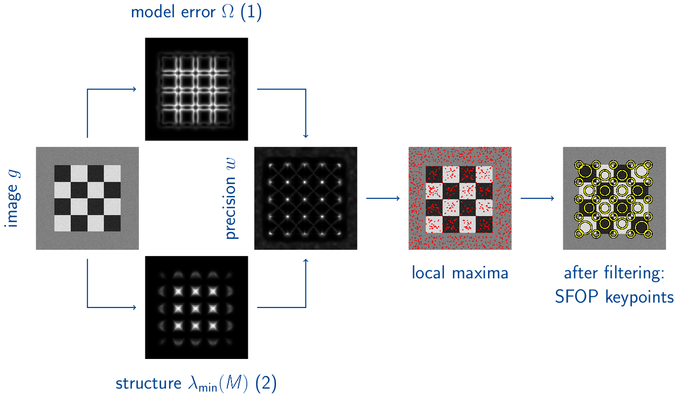Benutzer:Ipb.uni-bonn/Spielwiese
Zur Navigation springen
Zur Suche springen
Vorlage:FeatureDetectionCompVisNavbox
The Scale-invariant Feature Operator (or SFOP) is an algorithm in computer vision to detect local features in images. The algorithm was published by Förstner et al. in 2009.[1]
Algorithm
[Bearbeiten | Quelltext bearbeiten]The Scale-invariant Feature Operator (SFOP) is based on two theoretical concepts:
Desired properties of keypoint detectors:
- Invariance and repeatability for object recognition
- Accuracy to support camera calibration
- Interpretability: Especially corners and circles, should be part of the detected keypoints (see figure).
- As few control parameters as possible with clear semantics
- Complementarity to known detectors
scale-invariant corner/circle detector.
Theory
[Bearbeiten | Quelltext bearbeiten]Maximize the weight
[Bearbeiten | Quelltext bearbeiten]Maximize the weight = 1/variance of a point
comprising:
1. the image model[2]
- Distance d of an edge from a reference point p in a spiral feature
2. the smaller eigenvalue of the structure tensor
Reduce the search space
[Bearbeiten | Quelltext bearbeiten]Reduce the 5-dimensional search space by
- linking the differentiation scale to the integration scale
- solving for the optimal using the model
- and determining the parameters from three angles, e. g.
- pre-selection possible:
Filter potential keypoints
[Bearbeiten | Quelltext bearbeiten]- non-maxima suppression over scale, space and angle
- thresholding the isotropy :
eigenvalues characterize the shape of the keypoint, smallest eigenvalue has to be larger than threshold
derived from noise variance and significance level :
Algorithm
[Bearbeiten | Quelltext bearbeiten]
Results
[Bearbeiten | Quelltext bearbeiten]Interpretability of SFOP keypoints
[Bearbeiten | Quelltext bearbeiten]- Results of different detectors on a Siemens star
-
Sfop: junctions red, circular features cyan
-
Edge-based Regions
-
Intensity-based Regions
-
[MSER]
-
[Lowe]
See also
[Bearbeiten | Quelltext bearbeiten]External links
[Bearbeiten | Quelltext bearbeiten]- [1], the authors project website at University of Bonn
References
[Bearbeiten | Quelltext bearbeiten]- ↑ Förstner, Wolfgang, Dickscheid, Timo, and Schindler, Falko: Detecting Interpretable and Accurate Scale-Invariant Keypoints. 2009, S. 2256–2263 (uni-bonn.de [PDF]).
- ↑ a b Bigün, J.: A Structure Feature for Some Image Processing Applications Based on Spiral Functions. In: Computer vision, graphics, and image processing. 51. Jahrgang, Nr. 2. Academic Press, 1990, S. 166–194.
- ↑ "Förstner, Wolfgang",: A Framework for Low Level Feature Extraktion. Band 3, 1994, S. 383–394.
[[Category:Computer vision]]






![{\displaystyle {\begin{aligned}\Omega (\mathbf {p} ,\alpha ,\tau ,\sigma )&=\sum _{n=1}^{N(\sigma )}[(\mathbf {q} _{n}-\mathbf {p} )^{T}\mathbf {R} _{\alpha }\mathbf {\nabla } _{T}g(\mathbf {q} _{n})]^{2}G_{\sigma }(\mathbf {q} _{n}-\mathbf {p} )\\&=N(\sigma )\mathbf {tr} \left\{R_{\alpha }\mathbf {\nabla } _{\tau }\mathbf {\nabla } _{\tau }^{T}R_{\alpha }^{T}*\mathbf {p} \mathbf {p} ^{T}G_{\sigma }(\mathbf {p} )\right\}\end{aligned}}}](https://wikimedia.org/api/rest_v1/media/math/render/svg/4987bd95ff37a5a63645b2c69865695be3b5a04c)















![[MSER]](http://upload.wikimedia.org/wikipedia/commons/thumb/5/50/Ipb_siemens_mser.png/120px-Ipb_siemens_mser.png)
![[Harris affine]](http://upload.wikimedia.org/wikipedia/commons/thumb/e/ec/Ipb_siemens_haraff.png/117px-Ipb_siemens_haraff.png)
![[Hessian affine]](http://upload.wikimedia.org/wikipedia/commons/thumb/d/d7/Ipb_siemens_hesaff.png/120px-Ipb_siemens_hesaff.png)
![[Lowe]](http://upload.wikimedia.org/wikipedia/commons/thumb/3/3b/Ipb_siemens_sift.png/120px-Ipb_siemens_sift.png)